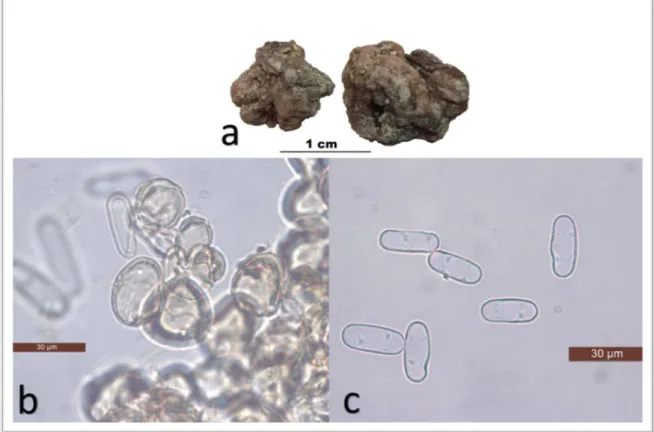MANTAR DERGİSİ/The Journal of Fungus Nisan(2019)10(1)23-25
23
Geliş(Recevied) :13/11/2018
Kabul(Accepted) :02/01/2019 Araştırma Makalesi/Research Article Doi:10.30708mantar.482166
A new genus (Balsamia) addition for Turkish mycota
Hakan ALLI
1, Hasan Hüseyin D
OĞAN
*2 *Corresponding author: hhuseyindogan@yahoo.com1Muğla Sıtkı Koçman University, Science Faculty, Biology Department, Muğla/TÜRKİYE
Orcid ID: 0000-0001-8781-7029/ hakanalli@gmail.com
2Selcuk University, Science Faculty, Biology Department, Konya/TÜRKİYE
Orcid ID:0000-0001-8859-0188/ hhuseyindogan@yahoo.com
Abstract: A hypogeous fungus Balsamia vulgaris Vittad. was collected from Muğla. This
species is well characterised by its peridial warts, long and elliptical spores with three oil drops.
Balsamia genus grows together with true truffles and they can frequently found in autumn and
winter.
Key words: False truffle, Balsamia, hypogeous fungi, Turkey.
Türkiye mikotası için yeni bir cins (Balsamia)
Öz: Muğla’dan yeraltı mantarı, Balsamia vulgaris Vittad. toplandı. Bu tür peridyal siğilleri,
üç yağ damlalı uzun ve eliptik sporlarıyla karakterizedir. Balsamia cinsi gerçek trüflerle beraber yetişmekte ve çoğunlukla sonbahar ve kış aylarında büyümektedir.
Anahtar kelimeler: Yalancı trüf, Balsamia, yeraltı mantarı, Türkiye Introduction
According to Index Fungorum data base program (2018), Balsamia genus are in Hellvellaceae family and it has 19 species in the World. Within these 19 species, 7 of them were newly described from Western North America by Southworth et al. (2018). Southworth et al. (2018) extensively studied American Balsamia collections by sequenced DNA, assessed relationships by sequence similarity, and identified molecular taxonomic units from the Northwest part of America. According to their results, ITS sequences supported 12 Balsamia species in Northwest of America. While Harkness (1899) and Fischer (1907) had originally described five of them, seven are new species.
In recent years, some new species and new records had been added to Turkish macromycota (Sesli and Denchev, 2014; Akata and Gürkanlı, 2018; Akata et al. 2018; Doğan et al., 2018; Sesli et al., 2018a, 2018b; Sesli and Liimatainen, 2018). With these studies, important contributions have been done to the biodiversity of our country. However, there are many species that are not identified in our country. Therefore, studies on macrofungi must continue without interruption.
Material and Methods
From fresh and dried specimens, hand sections were mounted in water and ascospores measured (20 randomly selected spores per collection) at 1000 x with a Leica DM3000 microscope and Leica software. Digital images were captured with a Leica DFC 495 camera. Spore dimensions were reported as mean and range (in parentheses) for length, width, and the ratio of length to width (Q). Terminology for description of ascomata tissues follows Montecchi and Sarasini (2000), Gori (2005) and Southworth et al. (2018). Specimens were deposited at the Fungarium of Muğla Sıtkı Koçman University. Results Taxonomy Ascomycota Pezizomycetes Pezizales Helvellaceae
Balsamia vulgaris Vittad., Monogr. Tuberac.
MANTAR DERGİSİ/The Journal of Fungus Nisan(2019)10(1)23-25
24
Description
Fruiting body: Hypogeous or subepigeous
tuberiform and knotted, sometimes lobed, lacking root and branch, 1-3 cm diam., varying in colour from light hazel brown when young to orange-ochre and rusty brown; exterior warty, finely papillate-verrucose with roundish, darker and separable papillae (Fig 1 a).
Peridium: Completely closed, 10-20(30) µm with a
pseudoparenchymatous structure formed by polygonal-roundish, yellowish elements (Fig 1 b).
Gleba: Whitish to pale yellow, numerous chambers
formed by labyrinthiform tramal plates.
Asci: Not visible due to very thin and hardly
colourable wall.
Ascospores: Cylindrical with rounded apex,
ellipsoid-cylindrical, with a thin and less than 1 µm, hyaline, smooth, generally with 3 guttules, 25- 30 × 11-14 µm ( Fig 1 c).
Habitat: Under Quercus robur L.
Collection examined: Muğla: Yatağan, Doğanköy
Village, 23 March 2018, A6866.
Remarks: According to Montecchi and Sarasini
(2000), it is considered as a toxic species, but we did not check its edibility. The closest species is Balsamia
polysperma Vittad.. B. vulgaris differs from B. polysperma
(other European species) by its bigger, more elongate and having three oil droplets of the spores. Asci are sometimes hardly visible on mature specimens due to their very thin and hardly colourable wall.
Figure 1: a; Ascocarps, b; Peridial cells, c; Ascospores.
References
Akata I. and Gürkanlı C.T. (2018). A New genus record for Turkish Clathroid fungi. The Journal of Fungus, 9(1) 36–38.
Akata, I., Kabaktepe, Ş., Sevindik, M. and Akgül, H. (2018). Macrofungi determined in Yuvacık Basin (Kocaeli) and its close environs. Kastamonu Univ.
Journal of Forestry Faculty, 18(2) 152–163
Doğan, H.H., Bozok, F. and Taşkın, H. (2018). A new species of Barssia (Ascomycota, Helvellaceae) from Turkey. Tr J Bot 42: 636–643.
Fischer, E. (1907). Über einige kalifornische Hypogaeen.
Berichte der Deutschen Botanischen Gesellschaft,
25: 373–376.
Gori, L. (2005). Funghi ipogei della Lucchesia, Marlia, Lucca: Maria Pacini Fazzi Editore.
MANTAR DERGİSİ/The Journal of Fungus Nisan(2019)10(1)23-25
25
Harkness, H.W. (1899). Californian hypogeous fungi.
Proceedings of the California Academy of Science, Series 3, Botany 1: 241–286.
Index Fungorum (2018). http://www.indexfungorum.org/ Names/Names.asp. Accessed 30 October 2018. Montecchi, A. and Sarasini, M. (2000). Funghi ipogei
d’europa, A Vicenza, Italy: M.B.Fondazione Centro
Studi Micologici.
Sesli, E., Antonin, V. and Contu M. (2018 a). A new species of Hygrophorus, H. yadigarii sp. nov. (Hygrophoraceae), with an isolated systematic position within the genus from the Colchic part of Turkey. Tr J Bot, 42: 224–232.
Sesli, E., Antonin, V. and Hughes, K.W. (2018 b).
Marasmiellus istanbulensis (Omphalotaceae), a
new species from Belgrade Forest (İstanbul-Turkey). Plant Biosystems, 152(4) 666–673. Sesli, E. and Denchev, C.M. (2014). Checklists of the
myxomycetes, larger ascomycetes, and larger basidiomycetes in Turkey. Mycotaxon, 106: 65–67 (2008). + online version 2014: 1-136.
Sesli, E. and Liimatainen K. (2018). Cortinarius
conicoumbonatus (Cortinarius subgen. Telamonia
sect. Hinnulei) a new species from spruce-beech forests of the East Black Sea Region of Turkey. Tr
J Bot, 42: 1–8.
Southworth, D., Frank, J.L., Castellano, M.A., Smith, M.E. and Trappe, J.M. (2018). Balsamia (Sequestrate Helvellaceae, Ascomycota) in western North America. Fungal Systematics and Evolution, 2: 11– 36.
